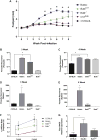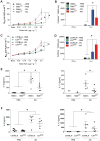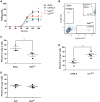CD11a polymorphisms regulate TH2 cell homing and TH2-related disease
- PMID: 23726040
- PMCID: PMC3842370
- DOI: 10.1016/j.jaci.2013.03.049
CD11a polymorphisms regulate TH2 cell homing and TH2-related disease
Abstract
Background: TH2-dependent diseases vary in severity according to genotype, but relevant gene polymorphisms remain largely unknown. The integrin CD11a is a critical determinant of allergic responses, and allelic variants of this gene might influence allergic phenotypes.
Objective: We sought to determine major CD11a allelic variants in mice and human subjects and their importance to allergic disease expression.
Methods: We sequenced mouse CD11a alleles from C57BL/6 and BALB/c strains to identify major polymorphisms; human CD11a single nucleotide polymorphisms were compared with allergic disease phenotypes as part of the international HapMap project. Mice on a BALB/c or C57BL/6 background and congenic for the other strain's CD11a allele were created to determine the importance of mouse CD11a polymorphisms in vivo and in vitro.
Results: Compared with the C57BL/6 allele, the BALB/c CD11a allele contained a nonsynonymous change from asparagine to aspartic acid within the metal ion binding domain. In general, the BALB/c CD11a allele enhanced and the C57BL/6 CD11a allele suppressed TH2 cell-dependent disease caused by the parasite Leishmania major and allergic lung disease caused by the fungus Aspergillus niger. Relative to the C57BL/6 CD11a allele, the BALB/c CD11a allele conferred both greater T-cell adhesion to CD54 in vitro and enhanced TH2 cell homing to lungs in vivo. We further identified a human CD11a polymorphism that significantly associated with atopic disease and relevant allergic indices.
Conclusions: Polymorphisms in CD11a critically influence TH2 cell homing and diverse TH2-dependent immunopathologic states in mice and potentially influence the expression of human allergic disease.
Keywords: AHR; Airway hyperreactivity; Asthma; CAMP; CD11a; Childhood Asthma Management Program; LD; LFA-1; Leukocyte function–associated antigen 1; Linkage disequilibrium; MIBD; Metal ion binding domain; OVA; Ovalbumin; PE; Phycoerythrin; Rag; Recombination-activating gene; SNP; Single nucleotide polymorphism; T(H)2 cell; WT; Wild-type; allele; allergic disease; biomarker; congenic; homing; polymorphism.
Copyright © 2013 American Academy of Allergy, Asthma & Immunology. Published by Mosby, Inc. All rights reserved.
Figures





Similar articles
-
Developmental control of integrin expression regulates Th2 effector homing.J Immunol. 2008 Apr 1;180(7):4656-67. doi: 10.4049/jimmunol.180.7.4656. J Immunol. 2008. PMID: 18354189
-
Non-MHC-linked Th2 cell development induced by soluble protein administration predicts susceptibility to Leishmania major infection.J Immunol. 1997 Sep 1;159(5):2147-53. J Immunol. 1997. PMID: 9278301
-
Identification of the Mhc region as an asthma susceptibility locus in recombinant congenic mice.Am J Respir Cell Mol Biol. 2011 Aug;45(2):295-303. doi: 10.1165/rcmb.2009-0369OC. Epub 2010 Oct 22. Am J Respir Cell Mol Biol. 2011. PMID: 20971879 Free PMC article.
-
Distinct immunological states in murine cutaneous leishmaniasis by immunising with different amounts of antigen: the generation of beneficial, potentially harmful, harmful and potentially extremely harmful states.Behring Inst Mitt. 1997 Feb;(98):153-9. Behring Inst Mitt. 1997. PMID: 9382736 Review.
-
Anti-leishmania effector functions of CD4+ Th1 cells and early events instructing Th2 cell development and susceptibility to Leishmania major in BALB/c mice.Adv Exp Med Biol. 1998;452:53-60. doi: 10.1007/978-1-4615-5355-7_7. Adv Exp Med Biol. 1998. PMID: 9889959 Review.
Cited by
-
Construction of T cell exhaustion model for predicting survival and immunotherapy effect of bladder cancer based on WGCNA.Front Oncol. 2023 May 30;13:1196802. doi: 10.3389/fonc.2023.1196802. eCollection 2023. Front Oncol. 2023. PMID: 37324016 Free PMC article.
-
Small molecule targeting of the STAT5/6 Src homology 2 (SH2) domains to inhibit allergic airway disease.J Biol Chem. 2018 Jun 29;293(26):10026-10040. doi: 10.1074/jbc.RA117.000567. Epub 2018 May 8. J Biol Chem. 2018. PMID: 29739850 Free PMC article.
-
Baseline gene expression in BALB/c and C57BL/6 peritoneal macrophages influences but does not dictate their functional phenotypes.Exp Biol Med (Maywood). 2025 Jan 3;249:10377. doi: 10.3389/ebm.2024.10377. eCollection 2024. Exp Biol Med (Maywood). 2025. PMID: 39830895 Free PMC article.
-
TMT-Based Quantitative Proteomic Analysis Reveals Downregulation of ITGAL and Syk by the Effects of Cycloastragenol in OVA-Induced Asthmatic Mice.Oxid Med Cell Longev. 2022 Oct 25;2022:6842530. doi: 10.1155/2022/6842530. eCollection 2022. Oxid Med Cell Longev. 2022. PMID: 36329800 Free PMC article.
-
Beta2-Integrins and Interacting Proteins in Leukocyte Trafficking, Immune Suppression, and Immunodeficiency Disease.Front Immunol. 2019 Feb 19;10:254. doi: 10.3389/fimmu.2019.00254. eCollection 2019. Front Immunol. 2019. PMID: 30837997 Free PMC article. Review.
References
-
- Lee SH, Corry DB. Homing alone? CD18 in infectious and allergic disease. Trends Mol Med. 2004;10:258–62. - PubMed
-
- Lee SH, Prince JE, Rais M, Kheradmand F, Shardonofsky F, Lu H, et al. Differential requirement for CD18 in T-helper effector homing. Nat Med. 2003;9:1281–6. - PubMed
-
- McDowall A, Leitinger B, Stanley P, Bates PA, Randi AM, Hogg N. The I domain of integrin leukocyte function-associated antigen-1 is involved in a conformational change leading to high affinity binding to ligand intercellular adhesion molecule 1 (ICAM-1) J Biol Chem. 1998;273:27396–403. - PubMed
Publication types
MeSH terms
Substances
Grants and funding
LinkOut - more resources
Full Text Sources
Other Literature Sources
Medical
Research Materials

